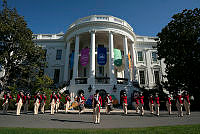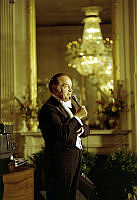Mrs. Polk Receives Unwelcome Advice About Her Servants
Copyright © White House Historical Association. All rights reserved under international copyright conventions. No part of this article may be reproduced or utilized in any form or by any means, electronic or mechanical, including photocopying, recording, or by any information storage and retrieval system, without permission in writing from the publisher. Requests for reprint permissions should be addressed to books@whha.org

This plateau, purchased by President Monroe, is likely the same one referred to in the Nelsons’ anecdote about Mrs. Polk and her servants.
James K. Polk and Sarah Childress Polk lived in the White House from 1845 to 1849. Anson and Fanny Nelson, admirers of Mrs. Polk, published this story many years later:
"An elderly lady, who had been present at [a White House] dinner-party, called on Mrs. Polk and said, 'May I take the liberty [to] make a suggestion to you, Madame?' The dining-table at the White House was adorned with a long mirror, . . . called the plateau, reflecting the light of the candelabra. . . . The table extended about a foot beyond the plateau, and this space was covered with a long napkin, which upon the removal of the dishes for dessert was rolled up by the servants, and formed a bulky bundle of linen. The lady’s suggestion was that the long napkin should be cut into short pieces, for the convenience of the servants. 'I seldom noticed these things,' said Mrs. Polk, 'and did not know when the napkin was rolled up and taken off, being engaged in conversation; . . .' [Mrs. Polk] said that the servants knew their duties, and she did not undertake the needless task of directing them."
—Anson and Fanny Nelson, Memorials of Sarah Childress Polk, Wife of the Eleventh President of the United States (New York: Anson D. F. Randolph Co., 1892), 110–111.







































